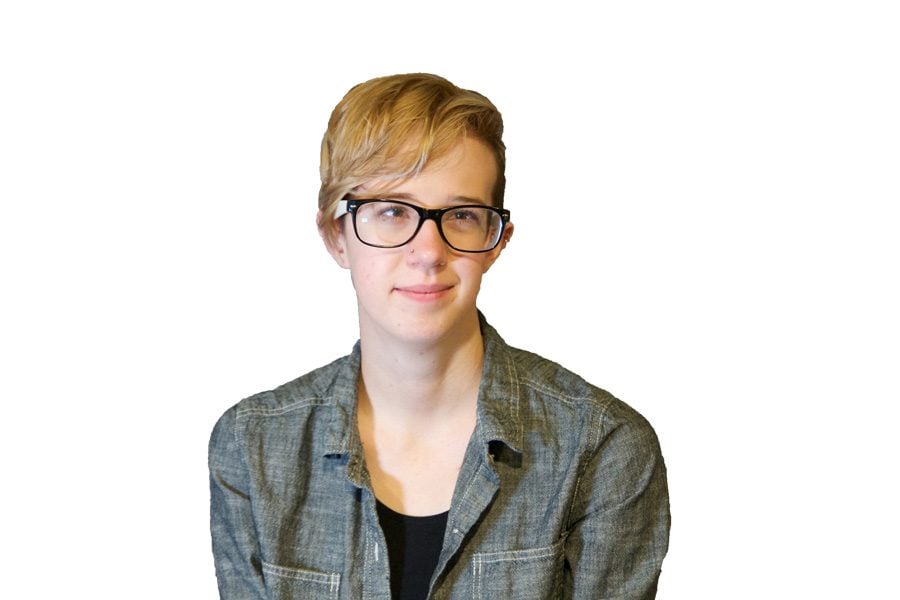The Spectrum: Existing outside of the gender binary
May 5, 2016
This essay is part of The Spectrum, a weekly forum in our Opinion section for marginalized voices to share their perspectives. To submit a piece for The Spectrum or discuss story ideas, please email [email protected].
“I am not female. I am not male. I am non-binary, and I am finally OK with that.”
As a journalist, I start every story with research. This time it was my own history, a look back through months of journals. I remembered “coming out” to myself, but the early date of the entry, November 2014, surprised me.
Looking through my notebooks, I realized I was hoping to show myself I had known all along. Certainty is an important part of the narrative, a way of assuring strangers our identities are real. Yet, I am not always certain.
“I am afraid to come out because there is no taking it back.”
Another journal entry, this time from last spring. It took a long time for me to embrace my identity. To accept that private questionings did not take away my right to public respect and that how I understood my gender was separate from how I explained it. Eventually, I accepted that I didn’t owe an explanation at all.
Last quarter, I did a story for class called “Navigating Non-Binary.” I asked all the obvious questions: How long have you known? Who have you told? My subjects were wonderfully patient with me. In a way, it was a search for validation. If you can be trans, if you can exist here, maybe I have the same right.
Existing at Northwestern has gone well, mostly because I am selective with whom I come out to. I was lucky enough to grow up in Southern California, a very liberal part of the country. I was confidently out as bisexual by my sophomore year of high school. Yet gender was different, even among the queer community. It was a distant, murky frontier. It was something you tried very hard to avoid talking or thinking about.
I vividly recall telling someone in high school I was “female by default.” I learned what transgender meant when my boyfriend came out in high school. I learned what non-binary was as an afterthought, the little plus sign that follows the LGBT. By the end of senior year, three of the four trans kids at my school had transferred out. This made it clear to me that being trans in high school was taboo.
I came out as trans in my senior year to a handful of close friends. I used the name Felix for a month or so, but it felt wrong.
Female. Male. I felt like I was checking off a box of things I was not. When I finally settled on non-binary sometime this January, my friends were amazingly supportive. Yet my family does not know and probably never will.
Most people on campus know me as Syd. I don’t know how many assume it’s just a nickname. Names are often an important part of the trans community, a way to announce and claim our own identities. I have a complicated relationship with my full name, but I ultimately decided to modify instead of change it. It still creeps up when talking to parents or professors. It’s still a part of my NU email, still an unavoidable part of my life.
Words are important. Names, pronouns and labels will vary from person to person. Some find comfort in them, others find power in rejecting them. I could write an entire column on the subtleties of pronoun preferences. I use they/them/theirs pronouns because it makes me more comfortable, and that is enough. I can’t speak for anyone else’s preferences. Trans as a blanket term — not just for transgender but non-binary, genderqueer, agender and many others — is something that takes getting used to. In a world where trans people face violence and discrimination, publicly identifying as trans feels like setting up a target. Despite this, finding a word to describe myself was a breath of relief and a reminder of solidarity.
I firmly believe that coming out is a myth. There will always be people who don’t know. There will always be a snap decision between visibility and simplicity, dysphoria and safety. I don’t remember the first person I told, but the process has not stopped since. My identity has changed from transgender to genderqueer to non-binary, but with each change, I feel I have come closer to representing who I am. Finding oneself is a process.
Syd Shaw is a Medill freshman. They can be contacted at [email protected]. If you would like to respond publicly to this column, send a Letter to the Editor to [email protected].
The views expressed in this piece do not necessarily reflect the views of all staff members of The Daily Northwestern.


